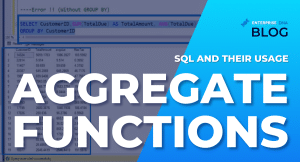Aggregate Functions In SQL And Their Usage

If you're working with SQL and need to summarize data from multiple rows into a single summary row, aggregate functions are a useful tool to have in your arsenal. In this tutorial, we'll explore the different types of aggregate functions available in SQL and how to use them effectively.

By utilizing aggregate functions, you can easily calculate values such as sums, averages, minimums, and maximums across various data sets. Some of the commonly used aggregate functions in SQL include AVG, COUNT, MIN, MAX, and SUM. Knowing how to use these functions can be incredibly helpful for data analysts and other professionals who work with SQL on a regular basis.
So if you're interested in expanding your SQL skills and improving your ability to summarize data, be sure to check out this tutorial. It provides a comprehensive guide to aggregate functions in SQL and offers practical examples to help you apply these concepts in your own work.
Continue reading Aggregate Functions In SQL And Their Usage at Enterprise DNA.
Published on:
Learn moreRelated posts
Use of aggregate, groupby in fetchxml query
This post dives into the use of aggregate and groupby functions in FetchXML queries. By utilizing these functions, users can create more compl...
PARTITION BY SQL: User Guide With Examples
For those looking to streamline data analysis in SQL, the PARTITION BY clause is a valuable tool worth exploring. This clause works in tandem ...
Running Total SQL: Cumulative Sum Examples
In the world of data analysis, tracking trends and conducting progressive trend analysis is a crucial part of unlocking valuable insights. Thi...
SQL Cheat Sheet: Quick Guide To Essential Commands
If you're a programmer or data analyst, you'll often work with large volumes of data. SQL (Structured Query Language) is one of the most power...
Developing with Azure SQL bindings and Azure SQL trigger for Azure Functions
This post sheds light on how to harness the combined power of Azure SQL bindings and triggers in Azure Functions to create event-driven scenar...
HAVING Clause In SQL Aggregate Functions
If you're looking to master HAVING Clause in SQL Aggregate Functions, you've come to the right place. In this tutorial from Enterprise DNA, yo...
Intro to aggregates in T-SQL
If you're new to T-SQL, this video tutorial is a great place to start. The focus is on using aggregate functions, which can help you get the r...
SQL 4 CDS 5.4 Released
The latest release of SQL 4 CDS, version 5.4, offers improved aggregate query performance and now includes .NET Core compatibility for develop...
Announcing JSON Enhancements in Azure SQL Database, Azure SQL Managed Instance and SQL Server 2022
Azure SQL Database, Azure SQL Managed Instance and SQL Server 2022 have recently announced enhancements to their JSON text processing capabili...